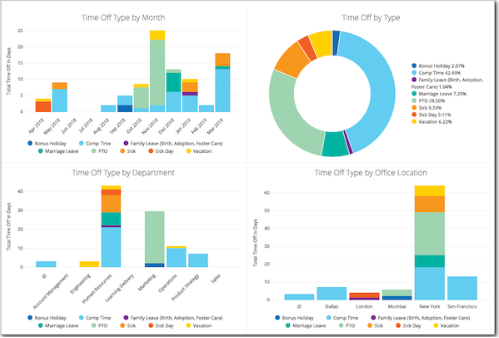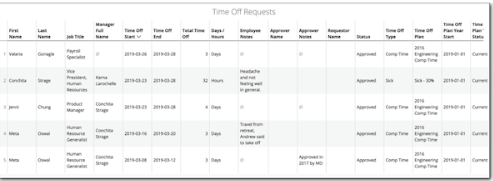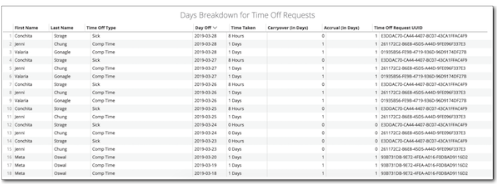Time Off Requests Dashboard
How to use the Time Off Requests dashboard, including information on filters, charts, and data tables.
OVERVIEW
The Time Off Requests dashboard provides a comprehensive view of trends in your employees’ time off. Use the dashboard’s filters to display specific time off information by approver, plan year, the request’s status, and more.
By default, the dashboard is set to display data from the last 12 months, and exclude time off requests that were declined or made by deleted profiles.
Note: The Time Off Requests dashboard only shows data from time off entered in Namely HCM. It will not display data from Namely Time or Namely Payroll.
Using Filters and Downloading Reports
For in-depth information on using Namely Analytics dashboards, including how to select filters and download reports, visit the Namely Analytics guide.
TIME OFF REQUEST CHARTS
Time Off Type by Month
The Time Off Type by Month chart displays the total number of days taken off in a specified date range. This chart may override your date range filter if days in some requests fall outside the filtered date range.
For example, if the date range filter is set to display requests from February 1, 2018, to January 31, 2019, but some of the requests from January 2019 include days in February 2019, the chart will display data for those days in February 2019.

Time Off by Type
The Time Off by Type chart displays percentage totals for any time off types you’ve chosen to display in your filter parameters.
Time Off Type by Department
The Time Off Type by Department chart displays the total number of days taken off by type for each department.
Time Off Type by Office Location
The Time Off by Office Location chart displays the total number of days taken off by type for each office location.
Time Off Request Status
Use the Time Off Request Status chart to see the percentage of requests that are currently approved, pending, or declined for each time off type.
Average Days Taken by Request
The Average Days Taken by Request chart can be used to see the amount of time that is typically requested off for each time off type.
Average Time Off by Employee
The Average Time Off by Employee chart to see the average number of days employees have taken by per employee and time off type.
Note: If an employee has zero time off requests, they are not currently included in the calculation for this chart.
Days Requested in Advance
Use the Time Off Request Status chart to see the average length of time before a time off request begins that employees submit the request. For example, is the request submitted hours or days in advance, or after the time off has commenced?

DATA TABLES
Time Off Requests Data Table
The Time Off Requests table displays all of your time off data as configured in your filters. Columns include:
-
First name (of employee)
-
Last name (of employee)
-
Job title (of employee)
-
Manager full name
-
Time off start date
-
Time off end date
-
Total time off (for this request)
-
Days or hours
-
Employee notes
-
Approver name
-
Approver notes
-
Requestor name
-
Request status (pending, approved, or declined)
-
Time off type
-
Time off plan
-
Time off plan start date
-
Date requested
-
Date responded
-
Last updated
-
Date deleted
-
Time off request UUID

Days Breakdown for Time Off Requests
Use the Days Breakdown for Time Off Requests table to see information on each day time off was taken in a specified date range, including the total amount of time taken by request, and whether the time came from carryover or accrual. Columns include:
-
First name (of employee)
-
Last name (of employee)
-
Time off type
-
Day off
-
Time taken
-
Carryover (in days): displays any time taken on this date that came from carryover. If the time off was only from accrual, it will display 0.
-
Accrual (in days): indicates the amount of time off taken on this date, including carryover.
-
Time off request UUIC

TIME OFF REQUEST FILTERS
Click filters at the top of the dashboard to refine your organization’s time off request information. You can filter by:
-
Approver Name: See who approved/declined the time off request. Pending time off requests will not have an approver name.
-
Department: Filter time off requests by department.
-
Division: Filter time off requests by division.
-
Employee Type: Filter time off requests by employee type.
-
First Name: Filter by an employee’s first name.
-
Last Name: Filter by an employee’s last name.
-
# of Days Off: Use this filter to see requests that are less than one day, greater than one day, or greater than five days.
-
Office Location: View time off requests made at specific office locations.
-
Request Status: View pending, approved, and denied requests. Note: By default, this filter is set to exclude denied requests.
-
Time Off Dates: Set the date range you want to view time off requests for. Note: By default, this filter is set to display the last 12 months.
-
Time Off Plan Year Status: View current, past, or future Time Off Plan Years. To see all time off requests for the current time off plan year, set Time Off Dates to is any time and Time Off Plan Year Status is equal to Current.
-
Time Off Plan: View results for specific time off plans.
-
Time Off Type: View results for specific time off types.
-
Days/Hours: View results by time off unit (either days or hours).
-
User Status: View results by employee user status.
-
Show Deleted Requests: View time off requests that were deleted. The default setting is No.
-
Show Scheduled Requests: If set to No, the dashboard will not display any current or upcoming time off requests. To show all requests, set to is any value.
-
Show Deleted Profiles: Displays time off requests submitted by deleted profiles. Note: The default setting is No